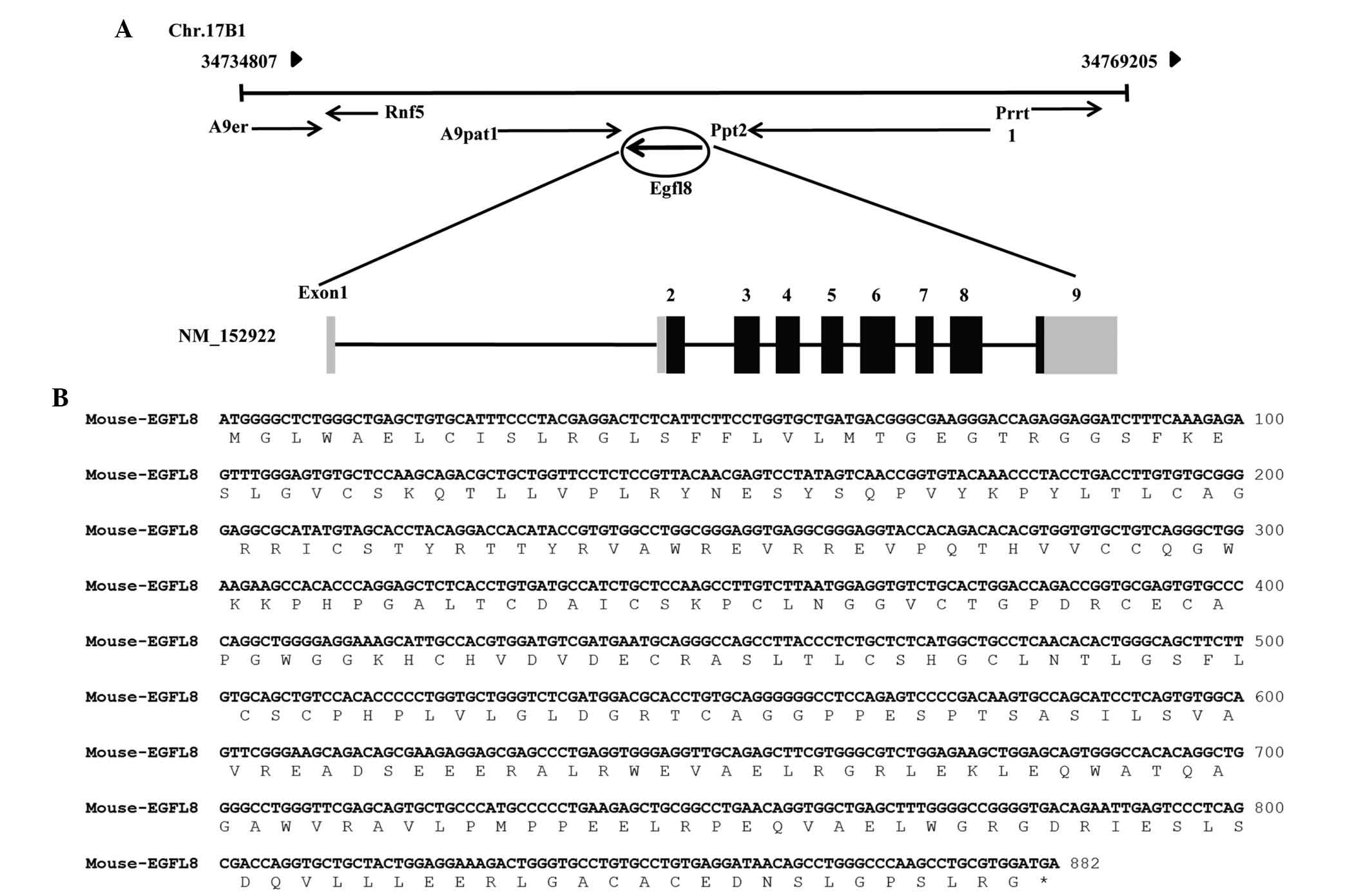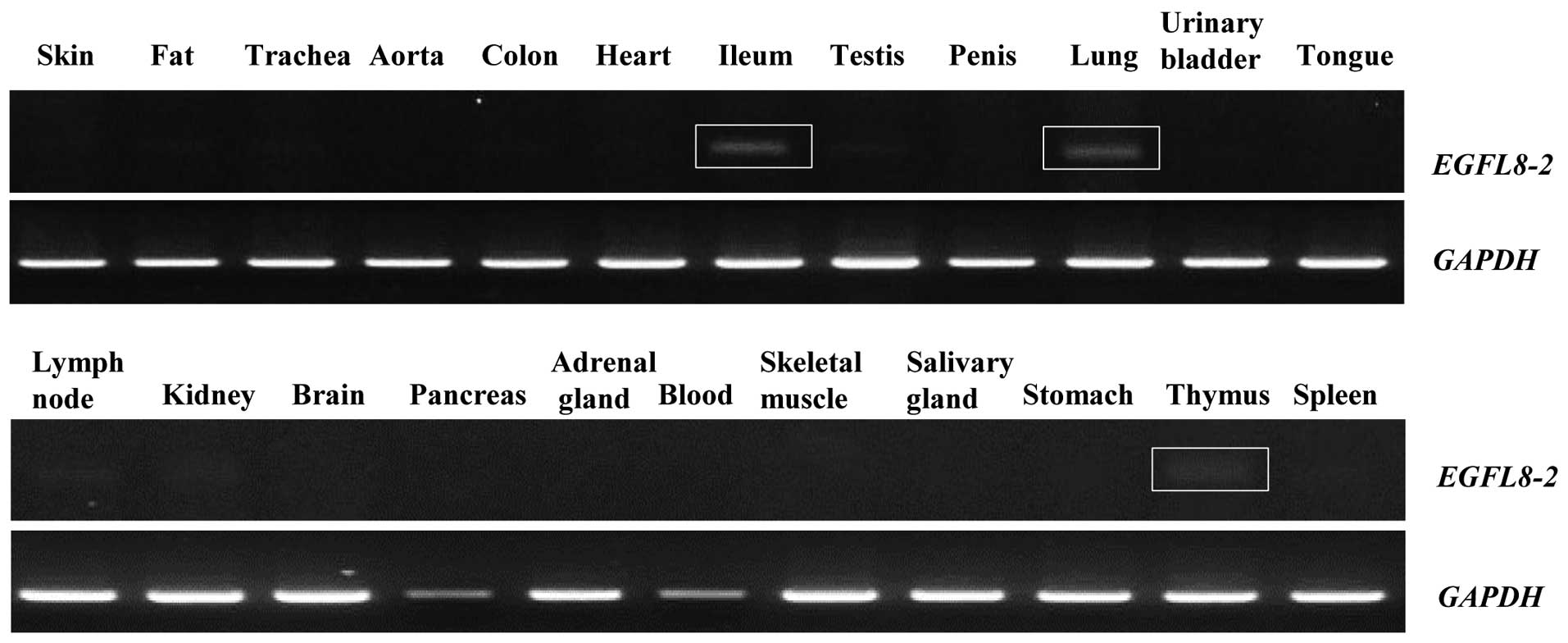|
1
|
Fitch MJ, Campagnolo L, Kuhnert F and
Stuhlmann H: Egfl7, a novel epidermal growth factor-domain gene
expressed in endothelial cells. Dev Dyn. 230:316–324. 2004.
View Article : Google Scholar : PubMed/NCBI
|
|
2
|
Koeppe JR, Beach MA, Baerga-Ortiz A, Kerns
SJ and Komives EA: Mutations in the fourth EGF-like domain affect
thrombomodulin-induced changes in the active site of thrombin.
Biochemistry. 47:10933–10939. 2008. View Article : Google Scholar : PubMed/NCBI
|
|
3
|
Kao YC, Jiang SJ, Pan WA, Wang KC, Chen
PK, Wei HJ, Chen WS, Chang BI, Shi GY and Wu HL: The epidermal
growth factor-like domain of CD93 is a potent angiogenic factor.
PLoS One. 7:e516472012. View Article : Google Scholar : PubMed/NCBI
|
|
4
|
Eroglu C, Allen NJ, Susman MW, et al:
Gabapentin receptor α2δ-1 is a neuronal thrombospondin receptor
responsible for excitatory CNS synaptogenesis. Cell. 139:380–392.
2009. View Article : Google Scholar : PubMed/NCBI
|
|
5
|
Koutsi A, Papapanagiotou A and
Papavassiliou AG: Thrombomodulin: From haemostasis to inflammation
and tumourigenesis. Int J Biochem Cell Biol. 40:1669–1673. 2008.
View Article : Google Scholar
|
|
6
|
Kojika S and Griffin JD: Notch receptors
and hematopoiesis. Exp Hematol. 29:1041–1052. 2001. View Article : Google Scholar : PubMed/NCBI
|
|
7
|
Ito D, Tanahashi N, Murata M, Sato H,
Saito I, Watanabe K and Fukuuchi Y: Notch3 gene polymorphism and
ischaemic cerebro-vascular disease. J Neurol Neurosurg Psychiatry.
72:382–384. 2002. View Article : Google Scholar : PubMed/NCBI
|
|
8
|
Campagnolo L, Leahy A, Chitnis S,
Koschnick S, Fitch MJ, Fallon JT, Loskutoff D, Taubman MB and
Stuhlmann H: EGFL7 is a chemoattractant for endothelial cells and
is up-regulated in angiogenesis and arterial injury. Am J Pathol.
167:275–284. 2005. View Article : Google Scholar : PubMed/NCBI
|
|
9
|
Nichol D, Shawber C, Fitch MJ, Bambino K,
Sharma A, Kitajewski J and Stuhlmann H: Impaired angiogenesis and
altered Notch signaling in mice overexpressing endothelial Egfl7.
Blood. 116:6133–6143. 2010. View Article : Google Scholar : PubMed/NCBI
|
|
10
|
Nichol D and Stuhlmann H: EGFL7: A unique
angiogenic signaling factor in vascular development and disease.
Blood. 119:1345–1352. 2012. View Article : Google Scholar :
|
|
11
|
Parker LH, Schmidt M, Jin SW, et al: The
endothelial-cell-derived secreted factor Egfl7 regulates vascular
tube formation. Nature. 428:754–758. 2004. View Article : Google Scholar : PubMed/NCBI
|
|
12
|
Dikic I and Schmidt MH: Notch:
Implications of endogenous inhibitors for therapy. BioEssays.
32:481–487. 2010. View Article : Google Scholar : PubMed/NCBI
|
|
13
|
Pinte S and Soncin F: Egfl7 promotes tumor
escape from immunity. Oncoimmunology. 1:375–376. 2012. View Article : Google Scholar : PubMed/NCBI
|
|
14
|
Schmidt MH, Bicker F, Nikolic I, Meister
J, Babuke T, Picuric S, Müller-Esterl W, Plate KH and Dikic I:
Epidermal growth factor-like domain 7 (EGFL7) modulates Notch
signalling and affects neural stem cell renewal. Nat Cell Biol.
11:873–880. 2009. View
Article : Google Scholar : PubMed/NCBI
|
|
15
|
Oberauer R, Rist W, Lenter MC, Hamilton BS
and Neubauer H: EGFL6 is increasingly expressed in human obesity
and promotes proliferation of adipose tissue-derived stromal
vascular cells. Mol Cell Biochem. 343:257–269. 2010. View Article : Google Scholar : PubMed/NCBI
|
|
16
|
Wang X, Gong Y, Wang D, et al: Analysis of
gene expression profiling in meningioma: Deregulated signaling
pathways associated with meningioma and EGFL6 overexpression in
benign meningioma tissue and serum. PLoS One. 7:e527072012.
View Article : Google Scholar
|
|
17
|
Wu F, Shirahata A, Sakuraba K, et al:
Down-regulation of EGFL8: A novel biomarker for advanced gastric
cancer. Anticancer Res. 31:3377–3380. 2011.PubMed/NCBI
|
|
18
|
Wu F, Shirahata A, Sakuraba K, et al:
Down-regulation of EGFL8: A novel prognostic biomarker for patients
with colorectal cancer. Anticancer Res. 31:2249–2254.
2011.PubMed/NCBI
|
|
19
|
Choi H-J, Yoon TD, Muhammad I, Jeong MH,
Lee J, Baek SY, Kim BS and Yoon S: Regulatory role of mouse
epidermal growth factor-like protein 8 in thymic epithelial cells.
Biochem Biophys Res Commun. 425:250–255. 2012. View Article : Google Scholar : PubMed/NCBI
|
|
20
|
Subhan F, Yoon TD, Choi HJ, Muhammad I,
Lee J, Hong C, Oh SO, Baek SY, Kim BS and Yoon S: Epidermal growth
factor-like domain 8 inhibits the survival and proliferation of
mouse thymocytes. Int J Mol Med. 32:952–958. 2013.PubMed/NCBI
|
|
21
|
Faas SJ, Rothstein JL, Kreider BL, Rovera
G and Knowles BB: Phenotypically diverse mouse thymic stromal cell
lines which induce proliferation and differentiation of
hematopoietic cells. Eur J Immunol. 23:1201–1214. 1993. View Article : Google Scholar : PubMed/NCBI
|
|
22
|
Sonnhammer EL, Eddy SR and Durbin R: Pfam:
A comprehensive database of protein domain families based on seed
alignments. Proteins. 28:405–420. 1997. View Article : Google Scholar : PubMed/NCBI
|
|
23
|
Appel RD, Bairoch A and Hochstrasser DF: A
new generation of information retrieval tools for biologists: The
example of the ExPASy WWW server. Trends Biochem Sci. 19:258–260.
1994. View Article : Google Scholar : PubMed/NCBI
|
|
24
|
Tamura K, Peterson D, Peterson N, Stecher
G, Nei M and Kumar S: MEGA5: molecular evolutionary genetics
analysis using maximum likelihood, evolutionary distance, and
maximum parsimony methods. Mol Biol Evol. 28:2731–2739. 2011.
View Article : Google Scholar : PubMed/NCBI
|
|
25
|
Saitou N and Nei M: The neighbor-joining
method: A new method for reconstructing phylogenetic trees. Mol
Biol Evol. 4:406–425. 1987.PubMed/NCBI
|
|
26
|
Thompson JD, Higgins DG and Gibson TJ:
CLUSTAL W: Improving the sensitivity of progressive multiple
sequence alignment through sequence weighting, position-specific
gap penalties and weight matrix choice. Nucleic Acids Res.
22:4673–4680. 1994. View Article : Google Scholar : PubMed/NCBI
|
|
27
|
Altschul SF, Madden TL, Schäffer AA, Zhang
J, Zhang Z, Miller W and Lipman DJ: Gapped BLAST and PSI-BLAST: A
new generation of protein database search programs. Nucleic Acids
Res. 25:3389–3402. 1997. View Article : Google Scholar : PubMed/NCBI
|
|
28
|
Emanuelsson O, Brunak S, von Heijne G and
Nielsen H: Locating proteins in the cell using TargetP, SignalP and
related tools. Nat Protoc. 2:953–971. 2007. View Article : Google Scholar : PubMed/NCBI
|
|
29
|
Lindsell CE, Shawber CJ, Boulter J and
Weinmaster G: Jagged: A mammalian ligand that activates Notch1.
Cell. 80:909–917. 1995. View Article : Google Scholar : PubMed/NCBI
|
|
30
|
Downing AK, Knott V, Werner JM, Cardy CM,
Campbell ID and Handford PA: Solution structure of a pair of
calcium-binding epidermal growth factor-like domains: Implications
for the Marfan syndrome and other genetic disorders. Cell.
85:597–605. 1996. View Article : Google Scholar : PubMed/NCBI
|
|
31
|
Nagata K, Kohda D, Hatanaka H, Ichikawa S,
Matsuda S, Yamamoto T, Suzuki A and Inagaki F: Solution structure
of the epidermal growth factor-like domain of heregulin-alpha, a
ligand for p180erbB-4. EMBO J. 13:3517–3523. 1994.PubMed/NCBI
|
|
32
|
Shah DK and Zúñiga-Pflücker JC: An
overview of the intrathymic intricacies of T cell development. J
Immunol. 192:4017–4023. 2014. View Article : Google Scholar : PubMed/NCBI
|
|
33
|
Andersson ER and Lendahl U: Therapeutic
modulation of Notch signalling - are we there yet? Nat Rev Drug
Discov. 13:357–378. 2014. View
Article : Google Scholar : PubMed/NCBI
|
|
34
|
Lobry C, Oh P, Mansour MR, Look AT and
Aifantis I: Notch signaling: Switching an oncogene to a tumor
suppressor. Blood. 123:2451–2459. 2014. View Article : Google Scholar : PubMed/NCBI
|
|
35
|
Hernandez Tejada FN, Galvez Silva JR and
Zweidler-McKay PA: The challenge of targeting notch in hematologic
malignancies. Front Pediatr. 2:542014. View Article : Google Scholar : PubMed/NCBI
|
|
36
|
Li Y, Ma J, Qian X, Wu Q, Xia J, Miele L,
Sarkar FH and Wang Z: Regulation of EMT by Notch signaling pathway
in tumor progression. Curr Cancer Drug Targets. 13:957–962. 2013.
View Article : Google Scholar : PubMed/NCBI
|
|
37
|
Aster JC: In brief: Notch signalling in
health and disease. J Pathol. 232:1–3. 2014. View Article : Google Scholar
|




















